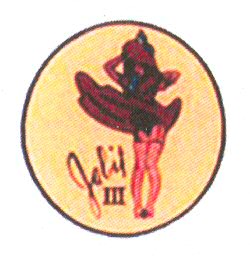History
One of 15 Silverplate B-29's used by the 509th CG, Jabit III was manufactured at the Glenn L. Martin Aircraft Plant at Omaha, Nebraska, as a block 35 Superfortress, one of 10 redesignated block 36 in recognition of its Silverplate status. It was delivered to the USAAF on April 3, 1945. Assigned to Crew B-6 (Captain John A. Wilson, Aircraft Commander), Jabit III was flown to its home base at Wendover Army Air Field, Utah, in April 1945, departing Wendover for North Field, Tinian on June 5, 1945, arriving on June 11.
Jabit III was originally assigned the Victor (unit-assigned aircraft identification) number 1 but on August 1 was given the large 'A' tail markings of the 497th Bomb Group as a security measure and had its Victor number changed to 71, to avoid misidentification with actual 497th BG aircraft. Jabit III was used by the group commander, Col. Paul Tibbets, on July 24 and 25 to drop two dummy Little Boy atomic bomb assemblies into the ocean off Tinian to test fire their radar altimeter components.
In addition to the Hiroshima mission and two test flights, Jabit III was flown by Capt. Wilson and crew B-6 on ten training and practice missions, and three combat missions, dropping pumpkin bombs on industrial targets in Taira, Ube, and Uwajima. 1st Lt. Ralph Devore and crew A-3 flew Jabit III on a pumpkin bomb mission to Osaka.
Jabit III and crew B-6 were one of two sent back to Wendover on August 9, 1945, to stage for possibly bringing back the plutonium core and initiator for a third atomic bomb, but the war ended before that occurred. The aircraft had been unnamed when it left Tinian but was possibly given a name and nose art during its return to the United States. It was damaged in a landing accident in Chicago on September 29, 1945, while on a training flight and was scrapped in April 1946.
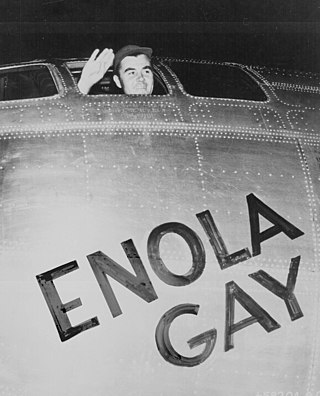
The Enola Gay is a Boeing B-29 Superfortress bomber, named after Enola Gay Tibbets, the mother of the pilot, Colonel Paul Tibbets. On 6 August 1945, during the final stages of World War II, it became the first aircraft to drop an atomic bomb in warfare. The bomb, code-named "Little Boy", was targeted at the city of Hiroshima, Japan, and destroyed about three-quarters of the city. Enola Gay participated in the second nuclear attack as the weather reconnaissance aircraft for the primary target of Kokura. Clouds and drifting smoke resulted in Nagasaki, a secondary target, being bombed instead.
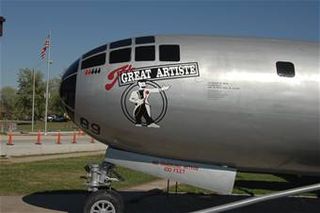
The Great Artiste was a U.S. Army Air Forces Silverplate B-29 bomber, assigned to the 393d Bomb Squadron, 509th Composite Group. The aircraft was named for its bombardier, Captain Kermit Beahan, in reference to his bombing talents. It flew 12 training and practice missions in which it bombed Japanese-held Pacific islands and dropped pumpkin bombs on targets in Japan. It was the only aircraft to have participated in both the bombings of Hiroshima and Nagasaki, albeit as an observation aircraft on each mission.

Straight Flush was the name of a B-29 Superfortress that participated in the atomic bomb attack on Hiroshima on August 6, 1945.

Project Alberta, also known as Project A, was a section of the Manhattan Project which assisted in delivering the first nuclear weapons in the atomic bombing of Hiroshima and Nagasaki during World War II.
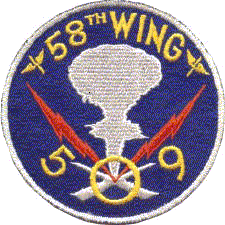
The 509th Composite Group was a unit of the United States Army Air Forces created during World War II and tasked with the operational deployment of nuclear weapons. It conducted the atomic bombings of Hiroshima and Nagasaki, Japan, in August 1945.
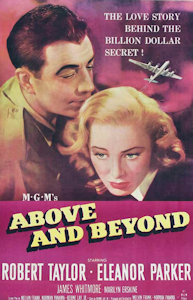
Above and Beyond is a 1952 American World War II film about Lt. Col. Paul W. Tibbets Jr., the pilot of the aircraft that dropped the atomic bomb on Hiroshima in August 1945.

Full House was the name of a B-29 Superfortress participating in the atomic bomb attack on Hiroshima on August 6, 1945.

Necessary Evil, also referred to as Plane #91, was the name of Boeing B-29-45-MO Superfortress 44-86291, participating in the atomic bomb attack on Hiroshima on August 6, 1945.
Up An' Atom was the name of a B-29 Superfortress configured during World War II in the Silverplate project to carry an atomic bomb.
Laggin' Dragon was the name of a Boeing B-29 Superfortress configured to carry the atomic bomb in World War II.

Big Stink – later renamed Dave's Dream – was a United States Army Air Forces Boeing B-29-40-MO Superfortress bomber that participated in the atomic bomb attack on Nagasaki, Japan on August 9, 1945. Assigned to the 393d Bomb Squadron, 509th Composite Group, it was used as a camera plane in support of the bomb-carrying B-29 Bockscar to photograph the explosion and effects of the bomb, and also to carry scientific observers. The mission was flown by crew C-14 but with Group Operations Officer Major James I. Hopkins, Jr., as the aircraft commander.

Silverplate was the code reference for the United States Army Air Forces' participation in the Manhattan Project during World War II. Originally the name for the aircraft modification project which enabled a B-29 Superfortress bomber to drop an atomic weapon, "Silverplate" eventually came to identify the training and operational aspects of the program as well. The original directive for the project had as its subject line "Silver Plated Project," but continued usage of the term shortened it to "Silverplate".
Some Punkins was the name of a B-29 Superfortress modified to carry an atomic bomb during World War II.
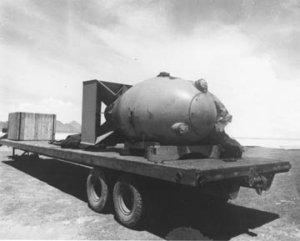
Pumpkin bombs were conventional aerial bombs developed by the Manhattan Project and used by the United States Army Air Forces against Japan during World War II. It was a close replication of the Fat Man plutonium bomb with the same ballistic and handling characteristics, but it used non-nuclear conventional high explosives. It was mainly used for testing and training purposes, which included combat missions flown with pumpkin bombs by the 509th Composite Group. The name "pumpkin bomb" was the term used in official documents from the large, fat ellipsoidal shape of the munition casing instead of the more usual cylindrical shape of other bombs, intended to enclose the Fat Man's spherical "physics package".
Next Objective was the name of a Boeing B-29-36-MO Superfortress, 44-27299, Victor 86, modified to carry the atomic bomb in World War II.

Top Secret was the name of a Boeing B-29 Superfortress modified to carry the atomic bomb in World War II. It served with the Army Air Forces and United States Air Force from 1945 until 1954.
Strange Cargo was the name of a B-29 Superfortress modified to carry the atomic bomb in World War II.
Luke the Spook was the name of a Boeing B-29-50-MO Superfortress configured to carry the atomic bomb in World War II.

Bockscar, sometimes called Bock's Car, is the United States Army Air Forces B-29 bomber that dropped a Fat Man nuclear weapon over the Japanese city of Nagasaki during World War II in the second – and most recent – nuclear attack in history. One of 15 Silverplate B-29s used by the 509th, Bockscar was built at the Glenn L. Martin Aircraft Plant at Bellevue, Nebraska, at what is now Offutt Air Force Base, and delivered to the United States Army Air Forces on 19 March 1945. It was assigned to the 393rd Bombardment Squadron, 509th Composite Group to Wendover Army Air Field, Utah, in April and was named after captain Frederick C. Bock.

The 216th Army Air Forces Base Unit (Special) provided base services at Wendover Army Airfield, where the 509th Composite Group was stationed during World War II. As such, it became involved in the Manhattan Project's program of testing bombs and aircraft under the codename Project W-47.
